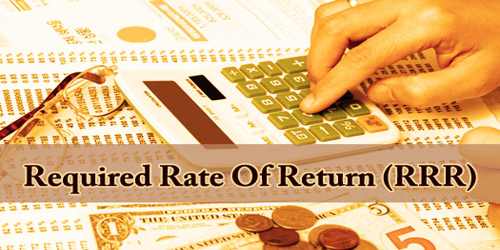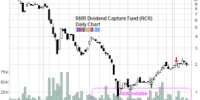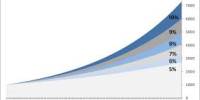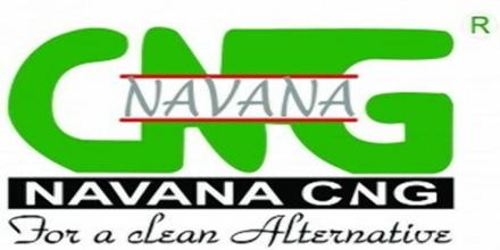The required rate of return (RRR) is the minimum return an investor will accept for owning a company’s stock, as compensation for a given level of risk associated with holding the stock. The RRR is also used in corporate finance to analyze the profitability of potential investment projects.
The required rate is commonly used as a threshold that separates feasible and unfeasible investment opportunities. The general rule is that if an investment’s return is less than the required rate, the investment should be rejected. The metric can be adjusted for the needs and goals of a particular investor. It can consider specific investment goals, as well as risk and inflation expectations.
The formula for Required Rate of Return (RRR): Required Rate of Return = Risk-Free Rate + Risk Co-efficient (Expected Return – Risk-free return)
The required rate of return is also known as the hurdle rate, which like RRR, denotes the appropriate compensation needed for the level of risk present. Riskier projects usually have higher hurdle rates or RRRs than those that are less risky.
Investors across the world use the required rate of return to calculate the minimum return they would accept on investment, after taking into consideration all available options. When calculating the required rate of return, investors look at overall market returns, risk-free rate of return, and volatility of the stock and overall project cost. The required rate of return drives the type of investments that can be made. For instance, someone requiring a higher rate of return would necessarily have to look at riskier investments. Finance professionals routinely calculate the required rate of return for purchasing new equipment, new product rollouts, and potential mergers.
For example, an investor who can earn 10 percent every year by investing in US Bonds, would set a required rate of return of 12 percent for a riskier investment before considering it.
There are different methods of calculating a required rate of return based on the application of the metric.
One of the most widely used methods of calculating the required rate is the Capital Asset Pricing Model (CAPM). Under the CAPM, the rate is determined using the following formula:
RRR = rf + ß(rm – rf)
Where:
RRR – required rate of return
rf – risk-free rate
ß – beta coefficient of an investment
rm – return of a market
The CAPM framework adjusts the required rate of return for an investment’s level of risk (measured by the beta) and inflation (assuming that the risk-free rate is adjusted for the inflation level).
Another method of calculating the required rate is the Weighted Average Cost of Capital (WACC). The WACC approach is frequently utilized in corporate finance. Unlike the CAPM, the WACC takes into consideration the capital structure of a company. Due to this, the required rate obtained from the WACC is used in the corporate decision-making process of undertaking new projects. It can be calculated using the following formula:
RRR = wDrD(1 – t) + were
Where:
wD – weight of debt
rD – cost of debt
t – corporate tax rate
we – weight of equity
re – cost of equity
The WACC determines the overall cost of the company’s financing. Therefore, the WACC can be viewed as a break-even return that determines the profitability of a project or an investment decision.
The required rate of return RRR is a key concept in equity valuation and corporate finance. It’s a difficult metric to pinpoint due to the different investment goals and risk tolerance of individual investors and companies. Risk-return preferences, inflation expectations, and a company’s capital structure all play a role in determining the company’s own required rate. Each one of these and other factors can have major effects on a security’s intrinsic value.
For investors using the CAPM formula, the required rate of return for a stock with a high beta relative to the market should have a higher RRR. The higher RRR relative to other investments with low betas is necessary to compensate investors for the added level of risk associated with investing in the higher beta stock.
In other words, RRR is in part calculated by adding the risk premium to the expected risk-free rate of return to account for the added volatility and subsequent risk.
For capital projects, RRR is useful in determining whether to pursue one project versus another. The RRR is what’s needed to go ahead with the project although some projects might not meet the RRR but are in the long-term best interests of the company.
Inflation must also be factored into RRR analysis. The RRR on a stock is the minimum rate of return on a stock that an investor considers acceptable, taking into account their cost of capital, inflation, and the return available on other investments.
For example, if inflation is 3% per year, and the equity risk premium over the risk-free return (using a U.S. Treasury bill which returns 3%), then an investor might require a return of 9% per year to make the stock investment worthwhile. This is because a 9% return is really a 6% return after inflation, which means the investor would not be rewarded for the risk they were taking. They would receive the same risk-adjusted return by investing in the 3% yielding Treasury bill, which would have a zero real rate of return after adjusting for inflation.
It is important to understand the concept of the required return as it is used by investors to decide on the minimum amount of return required from an investment. Based on the required returns an investor can decide whether to invest in an asset based on the given risk level.
The required return for a stock with a high beta relative to the market should have been higher because it is necessary to compensate investors for the added level of risk associated with the investment. Also, an investor can use the required returns for ranking the assets and eventually make the investment as per the ranking and include them in the portfolio. In short, the higher the expected return, the better is the asset.
RRR does not factor in the liquidity of an investment. If an investment can’t be sold for a period of time, the security will likely carry a higher risk than one that’s more liquid. Also, comparing stocks in different industries can be difficult since the risk or beta will be different. As with any financial ratio or metric, it’s best to utilize multiple ratios in your analysis when considering investment opportunities.
Information Sources:
















